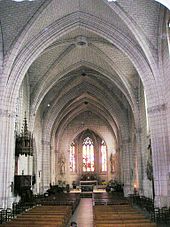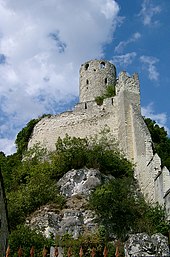Quinone
| Quinone | ||
|---|---|---|

|
|
|
| region | Center-Val de Loire | |
| Department | Indre-et-Loire | |
| Arrondissement | Quinone | |
| Canton | Chinon (main town) | |
| Community association | Chinon, Vienne et Loire | |
| Coordinates | 47 ° 10 ′ N , 0 ° 15 ′ E | |
| height | 27-112 m | |
| surface | 39.02 km 2 | |
| Residents | 8,242 (January 1, 2017) | |
| Population density | 211 inhabitants / km 2 | |
| Post Code | 37500 | |
| INSEE code | 37072 | |
| Website | www.ville-chinon.com | |
 Chinon, view over the old town and the bridge over the Vienne |
||
Chinon is a French town with 8242 inhabitants (at January 1, 2017) in Indre-et-Loire in the Région Center-Val de Loire and sub-prefecture of the arrondissement Chinon . The place extends over both banks of the Vienne , not far from the confluence with the Loire .
The city is known for the imposing ruins of Chinon Castle and the Chinon nuclear power plant with four active pressurized water reactors and three decommissioned Magnox reactors .
history
The strategically interesting site was already settled in the Neolithic . A Gallic oppidum was followed by a Gallo-Roman castrum . Among the first important Christians who worked in Chinon were Brictius von Tours (French Brice , around 370-444), a follower of Martin von Tours , who founded the Church of St. Martin and Mexme, founder of a church and a monastery. The place was first mentioned in writing as Caino in the 6th century by Gregory of Tours (538-594). From 964 to 1044, quinone came to the Counts of Blois . The builder of the first castle was Theobald I of Blois († 975). His descendant Theobald III. left the fief in 1044 to the Count of Anjou Gottfried II (French: Geoffroi or Geoffroy Martel).
When Heinrich Plantagenet , Duke of Anjou (1151), who had married Eleanor of Aquitaine in 1152 , ascended the English throne in 1154, Chinon fell under the rule of the English. Heinrich chose Chinon as his residence and passed away there after building large parts of the castle. This extends over 430 meters in length and 85 meters in width, the tower of which reaches a height of almost 40 meters. After him, the Chinon castle was temporarily inhabited by Richard the Lionheart and his brother Johann Ohneland and his wife Isabella von Angoulême . In 1205 the King of France Philip II August conquered Chinon and brought the Touraine into the royal domain.
In Chinon in 1429 Joan of Arc faced the Dauphin and later King Charles VII in the castle and received from him permission to march against the English in Orléans.
coat of arms
Blazon : In red three golden perspective, three-tower, brick castles, with gate, battlements and two windows on each tower, the larger central tower set back and covered, and three golden heraldic lilies in alternating order in two rows.
Versions: in addition to the modern perspective form of the brick castle with a roofed and tinned main tower and the uncovered, tinned front towers (flank towers), there is a castle shape with three identical, in a row, brick uncovered, flagged towers, the middle one with closed gate and one Version with covered and tinned main and tinned side towers, the latter with bricked conical bases and a window, the main tower with an open gate, chain slots and an open gate.
Attractions
The municipality is part of the Loire-Anjou-Touraine Regional Nature Park .
building
Among the buildings worth seeing are:
- Chinon Castle ruins , from which there is a beautiful view of the well-preserved city
- Collegiate church (10th / 11th century) and the former monastery of St. Mexme (now a school)
- Old town, with houses from the 15th and 16th centuries
- Church Notre-Dame de Parilly (12th century)
- Church Saint-Etienne (15th century)
- Saint-Maurice Church (12th-15th centuries)
- Tour de l'Horloge (clock tower), (12th century core)
- Tour Argenton (15th century)
Museums
Chinon is home to the following museums:
- Musée du Carroi ("Musée du Vieux Chinon": exhibits on the history of the city and its surroundings)
- Musée Jeanne-d'Arc in the "Tour de l'Horloge"
- Musée animé du vin (Wine Museum)
- Musée des arts et traditions populaires (Museum of Popular Arts and Traditions)
- Maison de la Rivière , Quai Pasteur, on the history of river navigation on the Loire
economy
The previously important quarries are no longer in operation today. The main sources of income are agriculture (grain), cattle breeding, cultivation of vines and fruit trees, the production of goat cheese and tourism. There is also a sawmill in Chinon. An industrial zone was established on the outskirts. A major employer near the city is the Chinon Nuclear Power Plant .
Chinon wine region
The wines produced here are currently among the best in France . Above the banks of the Vienne and open to visitors are the wine cellars, in which Chinon's famous Cabernet Franc red wines are stored. These "cellars" are actually caves that were carved into the porous limestone in order to extract the stones for the construction of the castle. Above all, the higher caves, the front of which received a lot of sunlight, were also often used as apartments by providing the entrance with a wall, doors and windows. In one of these caves was Musée Ste. Ragegonde furnished.
The AOC Chinon has 2200 hectares of vineyards and is located in the Touraine region, opposite the Bourgueil wine region (see also the article Val de Loire (IGP) ). The vineyards are divided into:
- Sand and gravel soils in the Véron region , the former flood plain between Loire and Vienne. Light wines grow here.
- Limestone and tuff slopes as well as adjacent plateaus around Cravant-les Côteaux , Sazilly and Beaumont-en-Véron . This is where medium-weight, top-class red wines are produced with excellent aging properties. In good vintages , an excellent quinone can be stored for several decades.
In 2002, 108,609 hectoliters of red wine (or small amounts of rosé ), and 1100 hl of white wine from the grape variety Chenin Blanc grapes.
Quinone in the movie
Chinon is the setting in two English films, the location of which was admittedly not the castle ruins:
- Becket (1963) based on the play Becket or the Glory of God by Jean Anouilh , written by Edward Anhalt ( Oscar 1964), directed by Peter Glenville , with Peter O'Toole (Henry II of England), Richard Burton (Thomas Becket) and John Gielgud (Louis VII of France). Filming locations were Shepperton Studios (England), Alnwick Castle and Bamburgh Castle .
- The Lion in Winter (1968), written by James Goldman , directed by Anthony Harvey , with Peter O'Toole (Henry II of England), Katharine Hepburn (Eleanor of Aquitaine), Anthony Hopkins (Richard the Lionheart), Nigel Terry (Johann Ohneland) . Filming locations were Ardmore Studios (Ireland), Montmajour Abbeynear Arles and Tarascon Castle.
- The Princess of Montpensier by Bertrand Tavernier (2010).
- L'Escargot noir (Movie made for TV by Claude Chabrol , 1988).
- In addition, the city of Chinon is the residence of the Verneuil family in the French comedies Monsieur Claude and his daughters (2014) and its sequel Monsieur Claude 2 (2019), both directed by Philippe de Chauveron .
Town twinning
Chinon, Hofheim and Tiverton form a “city triangle”, which means that they are also linked by partnerships.
Personalities
In Chinon were born:
- François Rabelais (around 1493; † 1553), Renaissance writer
- Jean-Philippe Grand (* 1953), car racing driver and racing team owner
literature
- Le Patrimoine des Communes d'Indre-et-Loire. Flohic Editions, Volume 1, Paris 2001, ISBN 2-84234-115-5 , pp. 435-453.
Web links
Individual evidence
- ^ Chinon - Heraldry of the World, Armorial de France, Armoires, Blason. www.ngw.nl, accessed on November 29, 2012 (English).






